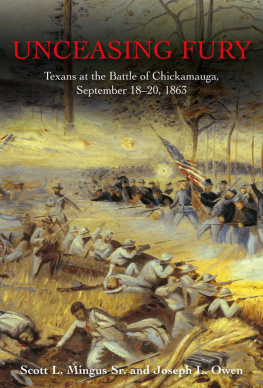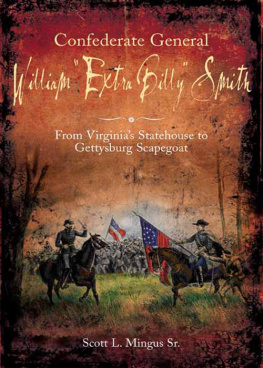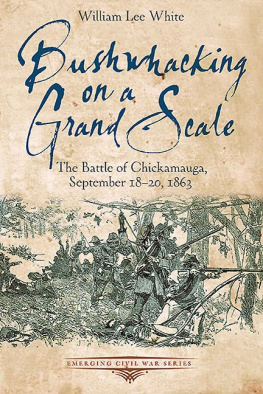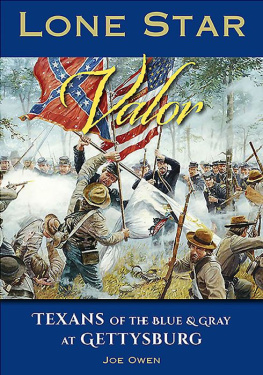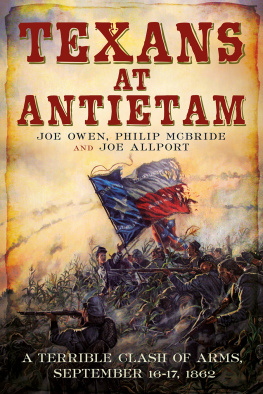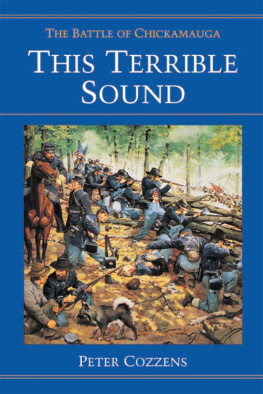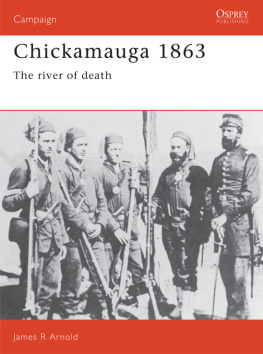Pagebreaks of the print version

Unceasing Fury
Texans at the Battle of Chickamauga
September 1820, 1863
Scott L. Mingus Sr. and Joseph L. Owen
2022 by Scott L. Mingus Sr. and Joseph L. Owen
All rights reserved. No part of this publication may be reproduced, stored in a retrieval system, or transmitted, in any form or by any means, electronic, mechanical, photocopying, recording, or otherwise, without the prior written permission of the publisher.
Library of Congress Cataloging-in-Publication Data
Names: Mingus, Scott L., Sr., author. | Owen, Joseph L., author.
Title: Unceasing Fury: Texans at the Battle of Chickamauga, September 18-20, 1863 / by Scott L. Mingus, Sr., and Joseph L. Owen.
Other titles: Texans at the Battle of Chickamauga, September 18-20, 1863
Description: El Dorado Hills, CA : Savas Beatie LLC, [2021] | Includes bibliographical references and index. | Summary: Thousands of Confederate soldiers from Texas fought at the Civil War battle of Chickamauga in September 1863 in northern Georgia. Many left personal accounts, letters, diaries, and postwar reminiscences that authors Scott Mingus and Joe Owen have woven into the first detailed narrative of the significant role that Lone Star soldiers played in the wars second-bloodiest battle Provided by publisher.
Identifiers: LCCN 2021029924 | ISBN 9781611215557 (hardcover) | ISBN 9781611215564 (ebook)
Subjects: LCSH: Chickamauga, Battle of, Ga., 1863. | TexasHistoryCivil War, 1861-1865Regimental histories. | United StatesHistoryCivil War, 1861-1865Regimental histories. | United StatesHistoryCivil War, 1861-1865Campaigns. | Confederate States of America. Army. Granburys Texas Brigade | Confederate States of America. Army. Greggs Brigade | Confederate States of America. Army. Ectors Brigade | Confederate States of America. Army. Dreshlers Brigade
Classification: LCC E475.81 .M56 2021 | DDC 973.7/35dc23
LC record available at https://lccn.loc.gov/2021029924
First Edition, First Printing
Savas Beatie
989 Governor Drive, Suite 102
El Dorado Hills, CA 95762
916-941-6896 /
Savas Beatie titles are available at special discounts for bulk purchases in the United States. Contact us for more details.
When the sable shades of night draped the hills of Chickamauga with a mournful
pall of earth-like silence, and the weeping stars lit the firmament over this
weird-like, ghostly scene, where the demon ghouls of death were reveling
in their gory feast and many a corpse lay ghastly pale in the arms of
eternal sleep, the bugle notes of victory recalled from pursuit the
shattered cohorts of the Southrons.
Dr. John O. Scott, former Confederate surgeon,
in a speech before the Old Settlers Picnic at Sherman, Texas,
on Aug. 20, 1896. (Chattanooga Daily Times, Sept. 6, 1896)
List of Maps
List of Illustrations
Chapter 1
Chapter 2
Chapter 3
Chapter 4
Chapter 5
Chapter 6
Chapter 7
Chapter 8
Chapter 9
Chapter 10
Chapter 11
Chapter 12
Chapter 13
List of Abbreviations
CCNMP: Chickamauga and Chattanooga National Military Park
CSR: Compiled Service Records
CV: Confederate Veteran
ETHJ: East Texas Historical Journal
GPO: Government Printing Office, Washington, DC
LOC: Library of Congress
LSU: Louisiana State University
MOLLUS: Military Order of the Loyal Legion of the United States
NPS: National Park Service
NARA: National Archives and Records Administration
OR: Official Records of the War of the Rebellion
RG: Record Group
SHQ: Southwestern Historical Quarterly
SHSP: Southern Historical Society Papers
THM: Texas Heritage Museum, Hill College
TSHA: Texas State Historical Association
UNC: University of North Carolina
USAHEC: United States Army Heritage and Education Center
UTSA: University of Texas-San Antonio
Foreword
The battle of Chickamauga lasted three days, involved nearly 130,000 combatants, thousands more non-combatants, civilians and soldiers alike, and produced roughly 35,000 casualties. In terms of violence and human suffering, it was the second largest battle of the American Civil War, trailing only the bloodletting at Gettysburg. While several other battles saw larger total numbers of men involved, Chickamauga excels in another grim way: virtually all the troops on both sides that met on those blood-soaked fields participated fully in that combat. Both the Union commander, Maj. Gen. William Starke Rosecrans, and the Confederate leader, Gen. Braxton Bragg, threw all their men into this fight. Few reserves were husbanded, and only a handful of regiments were assigned duties that took them away from the contestit was do or die for the men of both sides from September 18 to 20, 1863.
Chickamauga was one of the most important battles of the war. It was also a struggle that both sides would assert as a victory. How can that be?
First, to its importance. As the summer of 1863 closed, the cause of Southern independence was looking increasingly unlikely. Robert E. Lees retreat from Gettysburg allowed the Federals to claim a decisive victory in Pennsylvania, no matter how close-run a thing the fighting had been. Though tactically Gettysburg might be deemed a draw, Lees decision to return to Virginia confirmed the Army of Northern Virginias operational defeat. Simultaneously, the loss of Vicksburg, Mississippi, could not be described as anything other than a wholesale Confederate disaster, with Lt. Gen. John C. Pembertons entire Rebel army of 30,000 men surrendering to Union Maj. Gen. Ulysses S. Grant.
Rosecranss Army of the Cumberland, by contrast, drove Braggs Confederates out of Middle Tennessee via a campaign of brilliant maneuver. Because that campaign did not culminate in a major battle, however, it passed unnoticed nationally, overwhelmed in the newspaper headlines by news of Gettysburg and Vicksburg. Then, in September, Rosecrans launched a new effort aimed at Chattanooga. As if to answer the Unions earlier successes, Bragg, after abandoning Chattanooga to Union forces on September 9, suddenly won a seemingly decisive victory of his own against those invading Federals at Chickamauga.
To all outward appearances, Bragg and his Army of Tennessee delivered a drubbing to the Army of the Cumberland. A third of the Union army was routed off the field in the middle of the last days fighting. The remaining forces under Maj. Gen. George Thomas held on stubbornly for a time but were finally forced to retreatalbeit in a more organized fashionjust before dark. Several thousand Union prisoners, dozens of Federal cannons, and vast quantities of other equipment fell into Rebel hands. Rosecranss defeat triggered a crisis response in the Union high command and bolstered Southern morale at a critical moment in the war, after the earlier battering to public opinion of the summer. The euphoric reaction to Braggs success across the South, though slightly tempered with some dismay at the scope of his losses, seemed to confirm that the Confederacy had considerable life in her yet. The only question remaining to be answered was, could Bragg go on to seize the larger strategic fruits of that victory?
Which begs the second question: How could both sides claim victory? The answer was Chattanooga.

